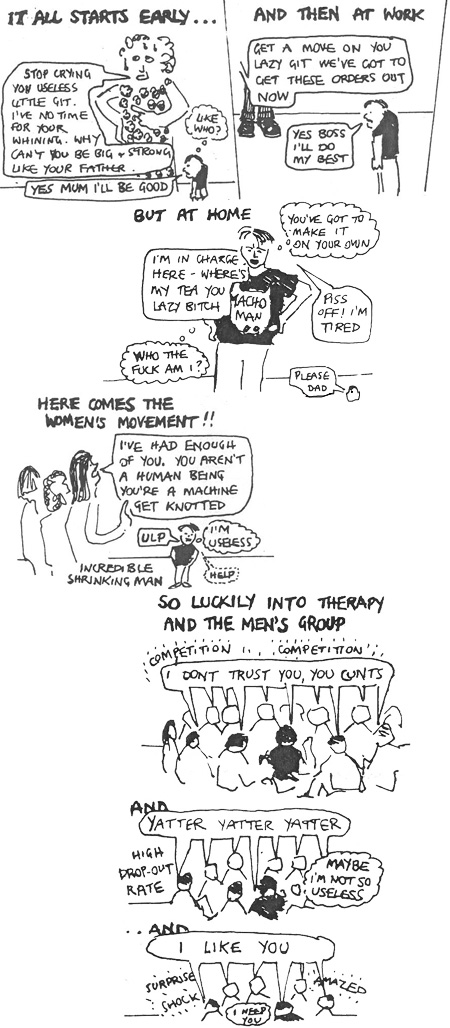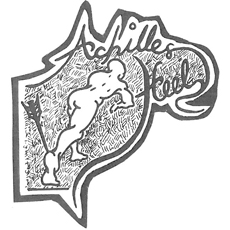Why we did it
Women were a majority within East London Big Flame. All of those women passionately identified themselves as feminists, and were or had been in women’s consciousness-raising groups. Where did that put us as heterosexual men? We saw the justice of the women’s movement. It couldn’t be denied that the wider world we lived in was run for the most part by men. Or that the authority which women for their part held in the arenas of family and childcare was largely demeaned, patronised and undervalued, as was emotionality itself. Some of us were confused, feeling at times that we carried the sins – and the privileges – of millennia of patriarchy on our shoulders. At the same time we wanted to resist that guilt, to start again from where we were, and find a way to be as men that acknowledged the history and supported the fight for equality and different values, but didn’t mean we had to be forever ashamed of our man-ness.
What we did
To begin to look at this, we needed to talk to one another. We needed the support of other men. We borrowed the model of consciousness-raising from feminism, and formed a group, made up of men from East London and Brixton. It was an experiment. We knew it would be a different experience for us than for women. It didn’t have a label or ideology, it was men talking to one another about their hopes and fears. Not all of us were active in Big Flame, and the group wasn’t defined by that connection. Some of us were influenced by Sheila Rowbotham’s pioneering work on the gender division of labour following the industrial revolution. The roles of men as breadwinners and women as home-makers were not part of any ‘natural’ order, but were historical. The emotional division of labour – between women as empathic care-givers, and men as ‘rational’ and invulnerable – wasn’t written in stone, and we could make a choice to re-order these priorities.
To start with, these conversations carried a sense of our identities being under threat. Before long it grew into a positive sense of wanting to re-shape ourselves and our lives. We liked being together. We liked talking together. We discovered that it was safe to share our vulnerability with one another, when so much male upbringing had been supposedly about bullying, competing and getting one over on one another. What had been once defensive became exciting and deeply meaningful. As we bonded and grew in strength and confidence, we felt moved to share our discoveries with other men.
We attended and helped to organise men’s conferences bringing together the men’s groups that were emerging nationally (see Achilles Heel No.4 Editorial, 1980). We founded and produced a magazine, Achilles Heel, intended as a kind of cousin to Spare Rib, which brought in other men and gave a voice to the burgeoning movement, and to the re-thinking of masculinity that went with it. We organised residential weeks for men and children. We attended demonstrations supporting, for example, A Woman’s Right to Choose. Over time the original group broadened its base: to include a gay man who had joined the Achilles Heel collective and a man who worked at Fords whom we had got close to through the Ford group. We eventually founded a men’s centre in a condemned building in Bethnal Green. We held men’s days, jointly with gay men.
And in our personal lives we committed ourselves to share childcare and housework, and to be emotionally open and adult, in as far as we knew how. Some of us also had therapy to help us with the last task, and introduced some of that therapy awareness into the men’s group.
We had the support of the women in East London Big Flame, and indeed for a period held exploratory open joint meetings. Some women in the broader feminist movement were hostile, seeing us as using the men’s movement to reclaim women's power. Some gay men were also angry at what they saw as an attempt by heterosexual men to claim victim status.
We were cautious about building a national organisation. We didn’t want to set up yet another hierarchical structure with middle class white men at the top. Men’s work in this period was to go inside and into the family; it was women who were staking a claim for access to the wider world.
The men’s work had no formal impact on the Ford Group, or the work with building workers. But it subtly changed how we talked to our contacts within Fords, and the breadth of the content we explored in the leaflets, for example how shift work affected peoples’ sex lives and intimate relationships. It had, and has, a pervasive strength.
Looking back ...
This was pioneering work, well ahead of its time, still percolating slowly into the mainstream. Some of us continued the work after Achilles Heel eventually wound down, in books and television programmes. And there have been subsequent generations of men who have taken up the mantle: a whole new editorial collective who re-vitalised Achilles Heel in the late 80s and early 90s. There was a wave of interest in Robert Bly’s work on rites of passage for men that remains a strong current. And the work around boys’ under-achievement at school that was begun at that time has strengthened and deepened over the years, as boys’ relative falling behind academically has become a national issue.
One of the group has more recently edited two collections of writings from the original Achilles Heel magazines: The Achilles Heel Reader: Men, Sexual Politics and Socialism (1991, reprinted 2012) and Men Sex, and Relationships: Writings from Achilles Heel (2004)
Role models for men in the mainstream have changed enormously. Men are expected now to attend births, change nappies, and to be engaged with children in a way previously rare or unthinkable. There’s currently a mini-explosion of ‘men’s work’ on a whole range of issues: suicide; men’s health; gang culture; AIDs among third world men; mentoring and role models for boys; rites of passage for older men; post-natal depression; aging.
There have been other currents that have been more ambivalent. The ‘men’s rights’ campaigners – like Fathers for Justice and others – have understandably fought against the inequities in divorce law etc. rooted in the traditional division of labour described above, which defined the home and childcare as women’s sphere. But they have somehow managed to project themselves as anti-woman rather than anti-sexist, and haven’t always helped their cause. We probably neglected these issues in reaction to that perceived misogyny, and missed engaging with another layer of men.
The shift to ‘lad’ culture in the 80s can be seen as a rearguard action to retain the props of traditional masculinity – beer, pubs, and a kind of exaggerated sexism with irony – without any of the sense of duty and responsibility that went with the role of breadwinner.
To grow up as a man in the UK today means hugely different challenges and choices to those we inherited growing up in the 1950s. We are proud to have played a part in opening up these questions.
